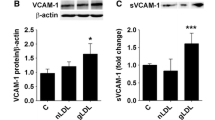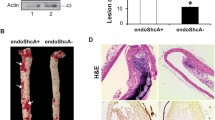Abstract
Many epidemiological studies predict a role for homocysteine (HCys) in cardiovascular disease occurrence, progression, and risk factors. In vitro studies demonstrated that HCys is an atherogenic determinant that promotes oxidant stress, inflammation, endothelial dysfunction and cell proliferation. This study originally attempted to examine the mechanism by which exposure of endothelial cells to HCys (0–250 µM) initiates inflammatory reaction and oxidative stress, by (i) investigating whether physiological and pathophysiological concentrations of HCys exhibit a prooxidative activity in vitro, (ii) examining the interaction of monocyte adhesion (Mono Mac 6) to monolayers of human microvascular endothelial cells (HMEC-1) exposed to different HCys concentrations, and (iii) examining if adherent monocytes increase reactive oxygen species either in endothelial cells or in monocytes themselves. However, our results demonstrate that HCys had neither prooxidative nor cytotoxic effects on endothelial cells. Only a moderate time- and concentration-dependent increase in monocyte adhesion up to 28.3 ± 5.5% was achieved relative to control after 4 h of HCys stimulation. This effect was accompanied by an increased VCAM and ICAM-1 mRNA expression. This “proinflammatory” effect appeared also when HMEC-1 cells were incubated with cysteine or glutathione at the concentration range 0–250 µM, demonstrating a non-specific rather than a specific HCys effect. In addition, adherent monocytes did not increase ROS formation neither in endothelial cells nor in monocytes themselves, indicating no direct or indirect cytotoxic or prooxidative effects of HCys.


Similar content being viewed by others
References
Ades EW, Candal FJ, Swerlick RA, George VG, Summers S, Bosse DC, Lawley TJ (1992) HMEC-1: establishment of an immortalized human microvascular endothelial cell line. J Invest Dermatol 99:683–690
Van den Berg M, Boers GH, Franken DG, Blom HJ, Van Kamp GJ, Jakobs C, Rauwerda JA, Kluft C, Stehouwert CD (1995) Hyperhomocysteinaemia and endothelial dysfunction in young patients with peripheral arterial occlusive disease. Eur J Clin Invest 25:176–181
Domagala TB, Undas A, Libura M, Szczeklik A (1998) Pathogenesis of vascular disease in hyperhomocysteinaemia. J Cardiovasc Risk 5:239–247
Dudman NP, Hicks C, Wang J, Wilcken DE (1991) Human arterial endothelial cell detachment in vitro: its promotion by homocysteine and cysteine. Atherosclerosis 91:77–83
Dudman NP, Temple SE, Guo XW, Fu W, Perry MA (1999) Homocysteine enhances neutrophil-endothelial interactions in both cultured human cells and rats In vivo. Circ Res 84:409–416
Duell PB, Malinow MR (1997) Homocyst(e)ine: an important risk factor for atherosclerotic vascular disease. Curr Opin Lipidol 8:28–34
Frank J, Kelleher DK, Pompella A, Thews O, Biesalski HK, Vaupel P (1998) Enhancement of oxidative cell injury and antitumor effects of localized 44 degrees C hyperthermia upon combination with respiratory hyperoxia and xanthine oxidase. Cancer Res 58:2693–2698
Hajjar KA (1993) Homocysteine-induced modulation of tissue plasminogen activator binding to its endothelial cell membrane receptor. J Clin Invest 91:2873–2879
Heinecke JW (2003) Oxidative stress: new approaches to diagnosis and prognosis in atherosclerosis. Am J Cardiol 91:12A–16A
Hofmann MA, Lalla E, Lu Y, Gleason MR, Wolf BM, Tanji N, Ferran LJ Jr, Kohl B, Rao V, Kisiel W, Stern DM, Schmidt AM (2001) Hyperhomocysteinemia enhances vascular inflammation and accelerates atherosclerosis in a murine model. J Clin Invest 107:675–683
Hultberg B, Andersson A, Isaksson A (1997) The cell-damaging effects of low amounts of homocysteine and copper ions in human cell line cultures are caused by oxidative stress. Toxicology 123:33–40
Jentzsch AM, Bachmann H, Furst P, Biesalski HK (1996) Improved analysis of malondialdehyde in human body fluids. Free Radic Biol Med 20:251–256
Kaul S, Zadeh AA, Shah PK (2006) Homocysteine hypothesis for atherothrombotic cardiovascular disease: not validated. J Am Coll Cardiol 48:914–923
LeBel CP, Ischiropoulos H, Bondy SC (1992) Evaluation of the probe 2′,7′-dichlorofluorescin as an indicator of reactive oxygen species formation and oxidative stress. Chem Res Toxicol 5:227–231
Lentz SR, Sadler JE (1993) Homocysteine inhibits von Willebrand factor processing and secretion by preventing transport from the endoplasmic reticulum. Blood 81:683–689
McCully KS (1969) Vascular pathology of hyperhomocysteinemia: implications for the pathogenesis of arteriosclerosis. Am J Pathol 56:111–128
McCully KS, Wilson RB (1975) Homocysteine theory of arteriosclerosis. Atherosclerosis 22:215–227
Poddar R, Sivasubramanian N, DiBello PM, Robinson K, Jacobsen DW (2001) Homocysteine induces expression and secretion of monocyte chemoattractant protein-1 and interleukin-8 in human aortic endothelial cells: implications for vascular disease. Circulation 103:2717–2723
Pruefer D, Scalia R, Lefer AM (1999) Homocysteine provokes leukocyte-endothelium interaction by downregulation of nitric oxide. Gen Pharmacol 33:487–498
Refsum H, Smith AD, Ueland PM, Nexo E, Clarke R, McPartlin J, Johnston C, Engbaek F, Schneede J, McPartlin C, Scott JM (2004) Facts and recommendations about total homocysteine determinations: an expert opinion. Clin Chem 50:3–32
Rodgers GM, Conn MT (1990) Homocysteine, an atherogenic stimulus, reduces protein C activation by arterial and venous endothelial cells. Blood 75:895–901
Ross R (1999) Atherosclerosis—an inflammatory disease. N Engl J Med 340:115–126
Royall JA, Ischiropoulos H (1993) Evaluation of 2′,7′-dichlorofluorescin and dihydrorhodamine 123 as fluorescent probes for intracellular H2O2 in cultured endothelial cells. Arch Biochem Biophys 302:348–355
Stamler JS, Osborne JA, Jaraki O, Rabbani LE, Mullins M, Singel D, Loscalzo J (1993) Adverse vascular effects of homocysteine are modulated by endothelium-derived relaxing factor and related oxides of nitrogen. J Clin Invest 91:308–318
Starkebaum G, Harlan JM (1986) Endothelial cell injury due to copper-catalyzed hydrogen peroxide generation from homocysteine. J Clin Invest 77:1370–1376
Stehouwer CD, Jakobs C (1998) Abnormalities of vascular function in hyperhomocysteinaemia: relationship to atherothrombotic disease. Eur J Pediatr 157 (Suppl 2):S107–S111
Suematsu M, Schmid-Schonbein GW, Chavez-Chavez RH, Yee TT, Tamatani T, Miyasaka M, Delano FA, Zweifach BW (1993) In vivo visualization of oxidative changes in microvessels during neutrophil activation. Am J Physiol 264:H881–H891
Tawakol A, Omland T, Gerhard M, Wu JT, Creager MA (1997) Hyperhomocyst(e)inemia is associated with impaired endothelium-dependent vasodilation in humans. Circulation 95:1119–1121
Wang G, Woo CW, Sung FL, Siow YL, O K (2002) Increased monocyte adhesion to aortic endothelium in rats with hyperhomocysteinemia: role of chemokine and adhesion molecules. Arterioscler Thromb Vasc Biol 22:1777–1783
Weiss N (2005) Mechanisms of increased vascular oxidant stress in hyperhomocys-teinemia and its impact on endothelial function. Curr Drug Metab 6:27–36
Welch GN, Loscalzo J (1998) Homocysteine and atherothrombosis. N Engl J Med 338:1042–1050
Woo KS, Chook P, Lolin YI, Cheung AS, Chan LT, Sun YY, Sanderson JE, Metreweli C, Celermajer DS (1997) Hyperhomocyst(e)inemia is a risk factor for arterial endothelial dysfunction in humans. Circulation 96:2542–2544
Woo KS, Chook P, Young RP, Sanderson JE (1997) New risk factors for coronary heart disease in Asia. Int J Cardiol 62 (Suppl 1):S39–S42
Xu Y, Swerlick RA, Sepp N, Bosse D, Ades EW, Lawley TJ (1994) Characterization of expression and modulation of cell adhesion molecules on an immortalized human dermal microvascular endothelial cell line (HMEC-1). J Invest Dermatol 102:833–837
Ziegler-Heitbrock HW, Thiel E, Futterer A, Herzog V, Wirtz A, Riethmuller G (1988) Establishment of a human cell line (Mono Mac 6) with characteristics of mature monocytes. Int J Cancer 41:456–461
Acknowledgment
The authors thank Dr. Gurunadh Reddy Chichili (Oklahoma Medical Research Foundation, Oklahoma, USA) for critical reading of the manuscript.
Author information
Authors and Affiliations
Corresponding author
Rights and permissions
About this article
Cite this article
Frank, J., Beck, S.C., Flaccus, A. et al. No evidence for prooxidative effects of homocysteine in vascular endothelial cells. Eur J Nutr 46, 286–292 (2007). https://doi.org/10.1007/s00394-007-0663-x
Received:
Accepted:
Published:
Issue Date:
DOI: https://doi.org/10.1007/s00394-007-0663-x




